A Report on Waterfront Urban Design by Sustainable Design Principles
VerifiedAdded on 2020/04/21
|13
|2814
|42
Report
AI Summary
This report delves into the principles of sustainable and humanized design within the context of waterfront urban development. It addresses key design issues such as climate change, accessibility, hydrophilicity, and publicity, analyzing challenges and proposing solutions. The report explores various natural form issues, including lakeside, riverside, and seaside types, providing case studies like Hamarby and the Alexander River to illustrate successful restoration and design strategies. Furthermore, it examines functional issues related to ecology and economy, particularly focusing on the 'sponge city' program in China as a model for sustainable urban development. The report emphasizes the importance of integrating conservation efforts, promoting economic growth, and balancing human activities with environmental considerations to create thriving and resilient waterfronts.
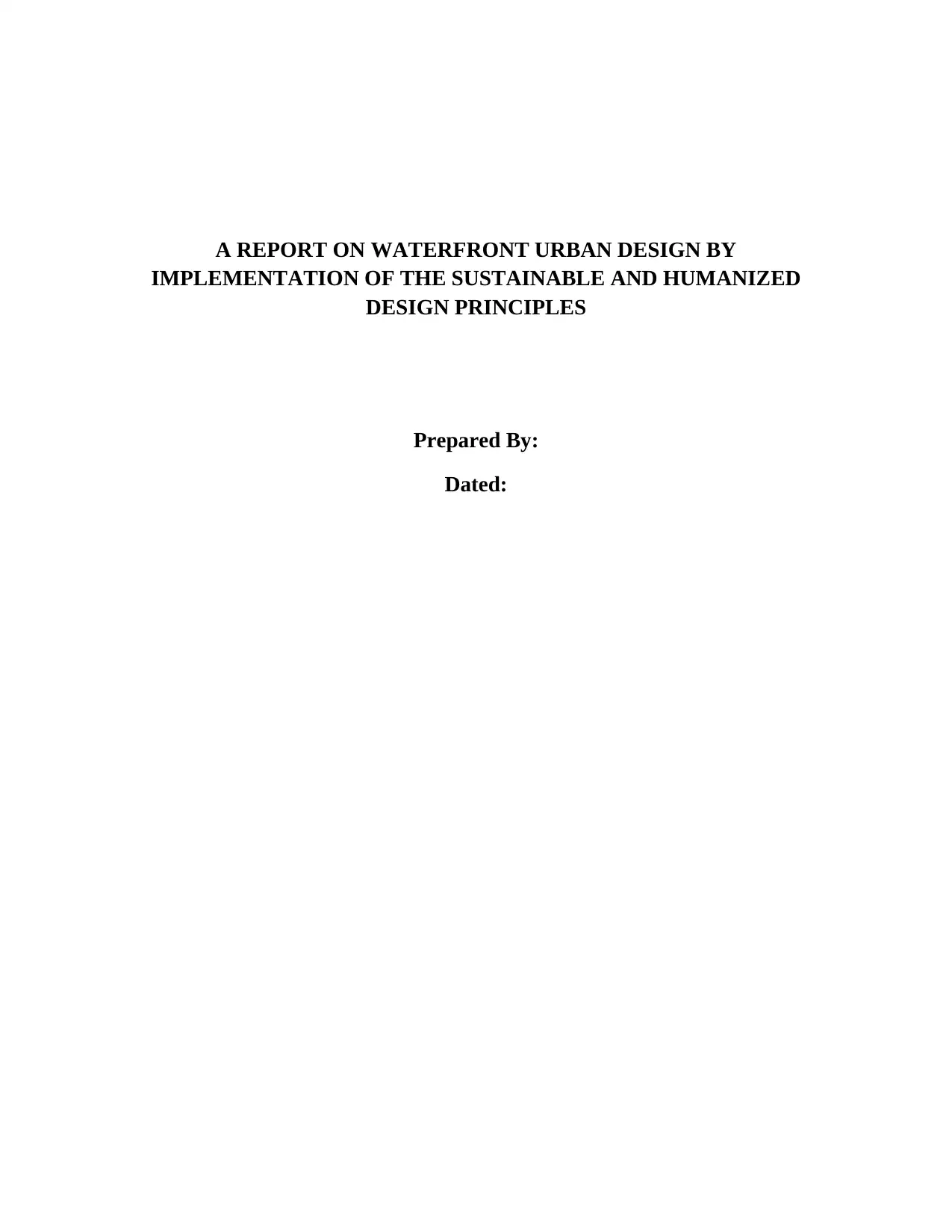
A REPORT ON WATERFRONT URBAN DESIGN BY
IMPLEMENTATION OF THE SUSTAINABLE AND HUMANIZED
DESIGN PRINCIPLES
Prepared By:
Dated:
IMPLEMENTATION OF THE SUSTAINABLE AND HUMANIZED
DESIGN PRINCIPLES
Prepared By:
Dated:
Paraphrase This Document
Need a fresh take? Get an instant paraphrase of this document with our AI Paraphraser
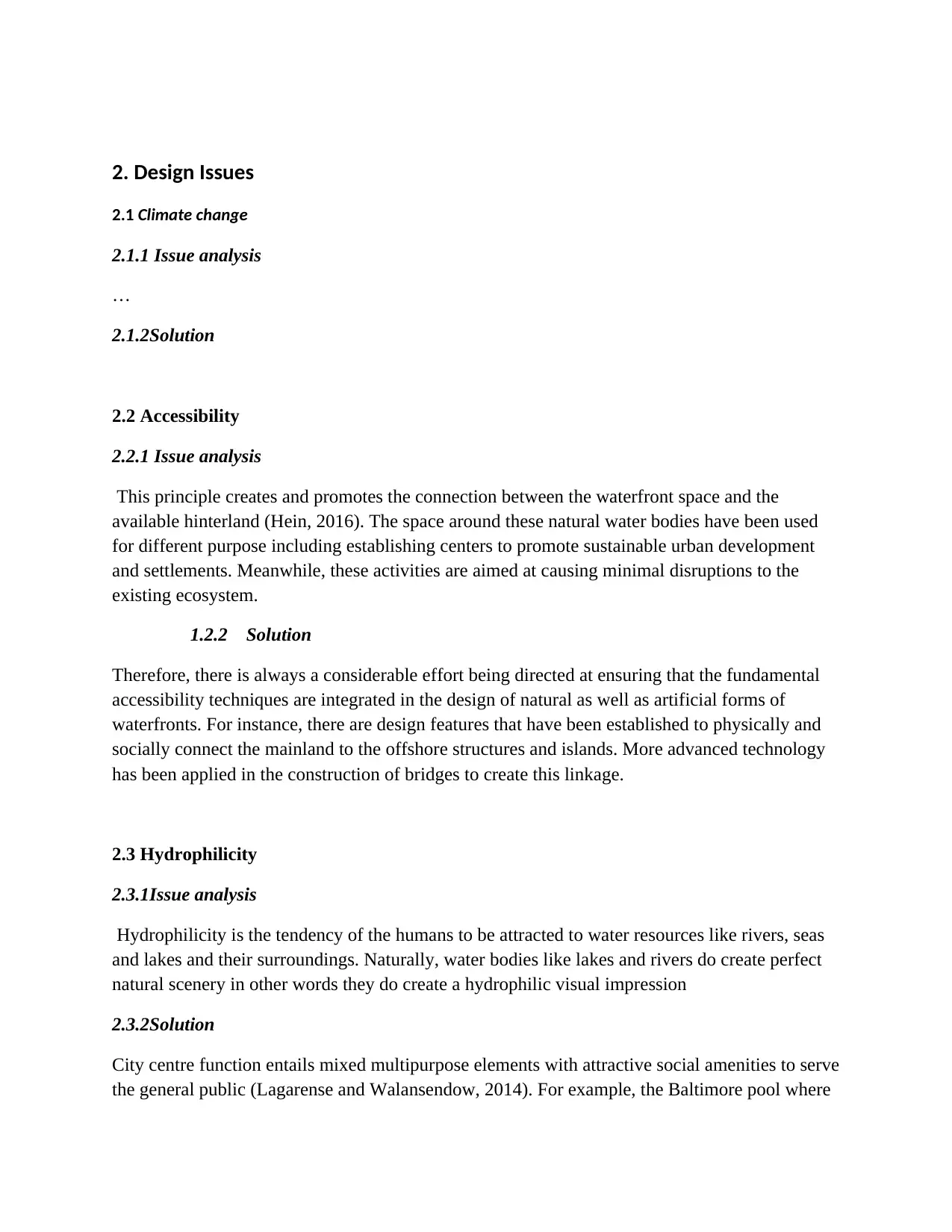
2. Design Issues
2.1 Climate change
2.1.1 Issue analysis
…
2.1.2Solution
2.2 Accessibility
2.2.1 Issue analysis
This principle creates and promotes the connection between the waterfront space and the
available hinterland (Hein, 2016). The space around these natural water bodies have been used
for different purpose including establishing centers to promote sustainable urban development
and settlements. Meanwhile, these activities are aimed at causing minimal disruptions to the
existing ecosystem.
1.2.2 Solution
Therefore, there is always a considerable effort being directed at ensuring that the fundamental
accessibility techniques are integrated in the design of natural as well as artificial forms of
waterfronts. For instance, there are design features that have been established to physically and
socially connect the mainland to the offshore structures and islands. More advanced technology
has been applied in the construction of bridges to create this linkage.
2.3 Hydrophilicity
2.3.1Issue analysis
Hydrophilicity is the tendency of the humans to be attracted to water resources like rivers, seas
and lakes and their surroundings. Naturally, water bodies like lakes and rivers do create perfect
natural scenery in other words they do create a hydrophilic visual impression
2.3.2Solution
City centre function entails mixed multipurpose elements with attractive social amenities to serve
the general public (Lagarense and Walansendow, 2014). For example, the Baltimore pool where
2.1 Climate change
2.1.1 Issue analysis
…
2.1.2Solution
2.2 Accessibility
2.2.1 Issue analysis
This principle creates and promotes the connection between the waterfront space and the
available hinterland (Hein, 2016). The space around these natural water bodies have been used
for different purpose including establishing centers to promote sustainable urban development
and settlements. Meanwhile, these activities are aimed at causing minimal disruptions to the
existing ecosystem.
1.2.2 Solution
Therefore, there is always a considerable effort being directed at ensuring that the fundamental
accessibility techniques are integrated in the design of natural as well as artificial forms of
waterfronts. For instance, there are design features that have been established to physically and
socially connect the mainland to the offshore structures and islands. More advanced technology
has been applied in the construction of bridges to create this linkage.
2.3 Hydrophilicity
2.3.1Issue analysis
Hydrophilicity is the tendency of the humans to be attracted to water resources like rivers, seas
and lakes and their surroundings. Naturally, water bodies like lakes and rivers do create perfect
natural scenery in other words they do create a hydrophilic visual impression
2.3.2Solution
City centre function entails mixed multipurpose elements with attractive social amenities to serve
the general public (Lagarense and Walansendow, 2014). For example, the Baltimore pool where

the region’s economic status has been boosted by the promotion of tourism and recreational
adventures, thanks to the hydrophilic nature of people. This was adopted by the implementation
of the comprehensive recreational business district. Besides, Han river is another example where
both sides of the land surrounding the river has been arranged with urban debris. Connectedly,
this has generated a number of scenic spots , each serving cultural significance and embodying
both social and economical supports to the urban development. Consequently, the following
amenities have mushroomed: leisure zones, commercial complexes, industrial heritages, cultural
arts district, city terrace, city parlour, business renaissance, moonlight cultural spots and cultural
theme parks all beautifully aligned along the edges of the riverside.
2.4 Publicity
2.4.1Issue analysis
2.4.2Solution
3. Natural form issues
As mentioned earlier, it is crucial to maintain the natural forms such as rivers and lakes against
human and industrial interference. The human activities must support the conservation efforts of
these natural resources. In fact, with proper conservation measures in place, the available natural
water sources can be used to sustainably supply clean water for domestic use hence supporting
the urban life abundantly. In this section we revisit some of the case examples that have
successfully been restored into sustainable and eco-friendly sources.
Notably, the residences are promoting tourism and other commercial activities in a great way.
The management of the area is under the local municipality which adopts and implements sound
protection measures against urbanization and other emerging factors.
3.1 Lakeside type
3.1.1 Issue analysis
adventures, thanks to the hydrophilic nature of people. This was adopted by the implementation
of the comprehensive recreational business district. Besides, Han river is another example where
both sides of the land surrounding the river has been arranged with urban debris. Connectedly,
this has generated a number of scenic spots , each serving cultural significance and embodying
both social and economical supports to the urban development. Consequently, the following
amenities have mushroomed: leisure zones, commercial complexes, industrial heritages, cultural
arts district, city terrace, city parlour, business renaissance, moonlight cultural spots and cultural
theme parks all beautifully aligned along the edges of the riverside.
2.4 Publicity
2.4.1Issue analysis
2.4.2Solution
3. Natural form issues
As mentioned earlier, it is crucial to maintain the natural forms such as rivers and lakes against
human and industrial interference. The human activities must support the conservation efforts of
these natural resources. In fact, with proper conservation measures in place, the available natural
water sources can be used to sustainably supply clean water for domestic use hence supporting
the urban life abundantly. In this section we revisit some of the case examples that have
successfully been restored into sustainable and eco-friendly sources.
Notably, the residences are promoting tourism and other commercial activities in a great way.
The management of the area is under the local municipality which adopts and implements sound
protection measures against urbanization and other emerging factors.
3.1 Lakeside type
3.1.1 Issue analysis
⊘ This is a preview!⊘
Do you want full access?
Subscribe today to unlock all pages.

Trusted by 1+ million students worldwide
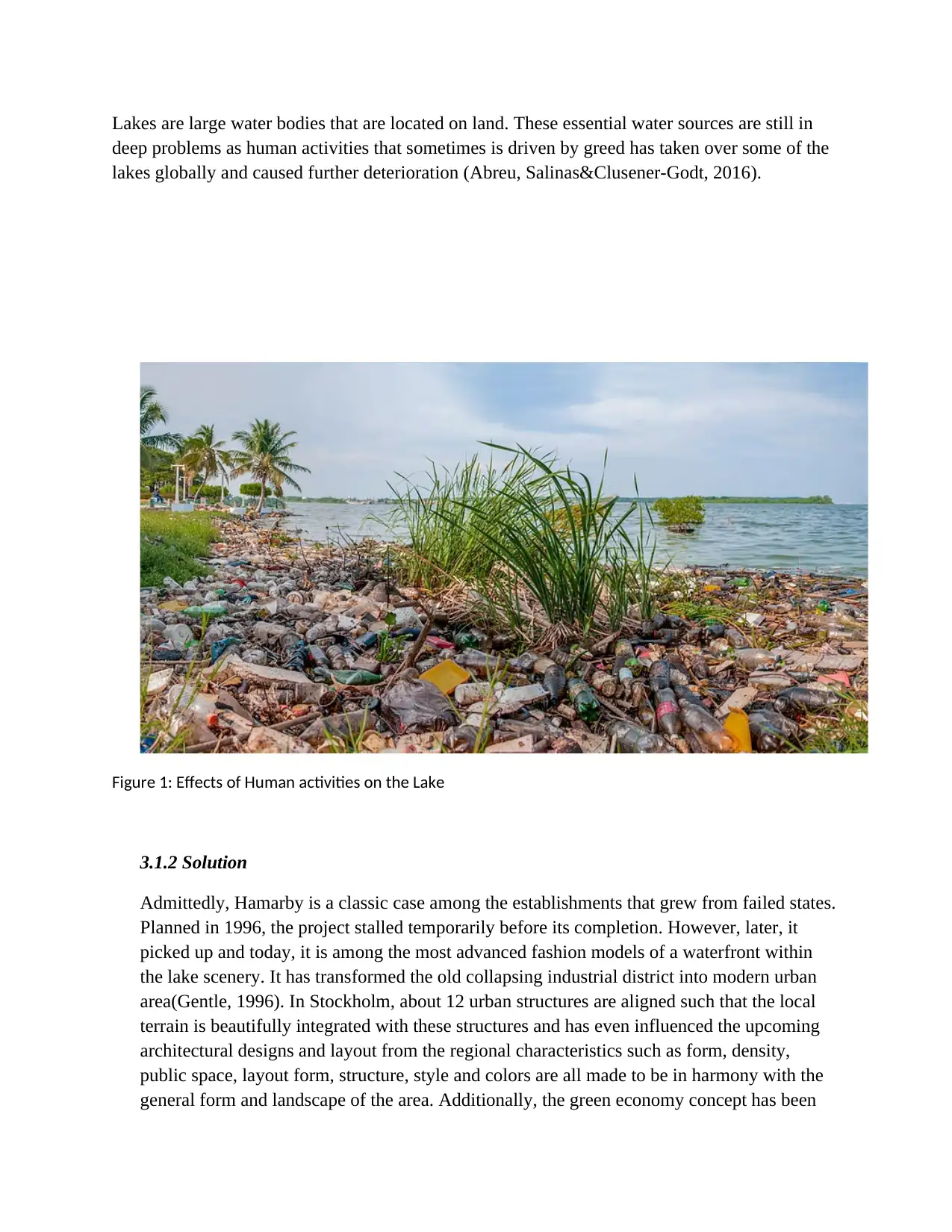
Lakes are large water bodies that are located on land. These essential water sources are still in
deep problems as human activities that sometimes is driven by greed has taken over some of the
lakes globally and caused further deterioration (Abreu, Salinas&Clusener-Godt, 2016).
Figure 1: Effects of Human activities on the Lake
3.1.2 Solution
Admittedly, Hamarby is a classic case among the establishments that grew from failed states.
Planned in 1996, the project stalled temporarily before its completion. However, later, it
picked up and today, it is among the most advanced fashion models of a waterfront within
the lake scenery. It has transformed the old collapsing industrial district into modern urban
area(Gentle, 1996). In Stockholm, about 12 urban structures are aligned such that the local
terrain is beautifully integrated with these structures and has even influenced the upcoming
architectural designs and layout from the regional characteristics such as form, density,
public space, layout form, structure, style and colors are all made to be in harmony with the
general form and landscape of the area. Additionally, the green economy concept has been
deep problems as human activities that sometimes is driven by greed has taken over some of the
lakes globally and caused further deterioration (Abreu, Salinas&Clusener-Godt, 2016).
Figure 1: Effects of Human activities on the Lake
3.1.2 Solution
Admittedly, Hamarby is a classic case among the establishments that grew from failed states.
Planned in 1996, the project stalled temporarily before its completion. However, later, it
picked up and today, it is among the most advanced fashion models of a waterfront within
the lake scenery. It has transformed the old collapsing industrial district into modern urban
area(Gentle, 1996). In Stockholm, about 12 urban structures are aligned such that the local
terrain is beautifully integrated with these structures and has even influenced the upcoming
architectural designs and layout from the regional characteristics such as form, density,
public space, layout form, structure, style and colors are all made to be in harmony with the
general form and landscape of the area. Additionally, the green economy concept has been
Paraphrase This Document
Need a fresh take? Get an instant paraphrase of this document with our AI Paraphraser
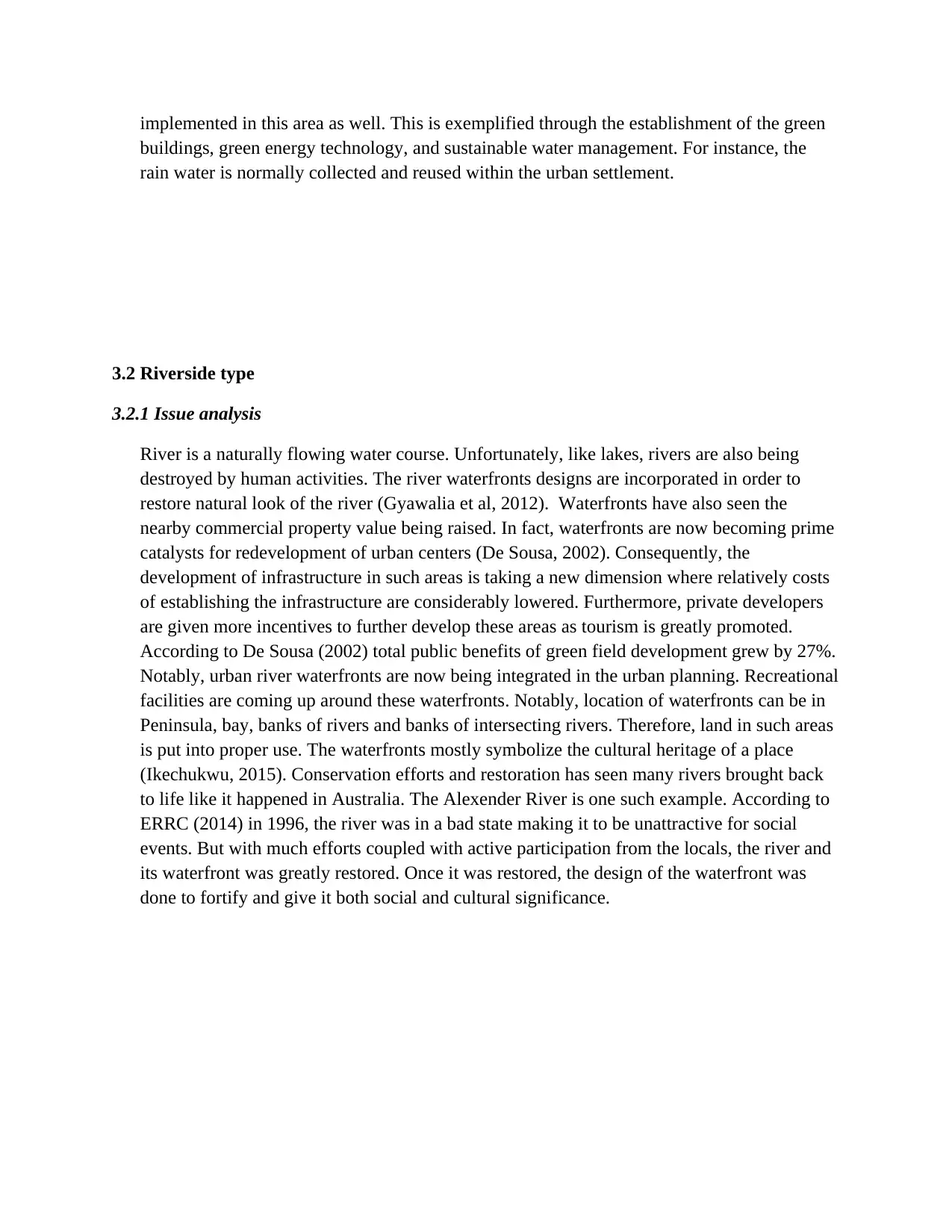
implemented in this area as well. This is exemplified through the establishment of the green
buildings, green energy technology, and sustainable water management. For instance, the
rain water is normally collected and reused within the urban settlement.
3.2 Riverside type
3.2.1 Issue analysis
River is a naturally flowing water course. Unfortunately, like lakes, rivers are also being
destroyed by human activities. The river waterfronts designs are incorporated in order to
restore natural look of the river (Gyawalia et al, 2012). Waterfronts have also seen the
nearby commercial property value being raised. In fact, waterfronts are now becoming prime
catalysts for redevelopment of urban centers (De Sousa, 2002). Consequently, the
development of infrastructure in such areas is taking a new dimension where relatively costs
of establishing the infrastructure are considerably lowered. Furthermore, private developers
are given more incentives to further develop these areas as tourism is greatly promoted.
According to De Sousa (2002) total public benefits of green field development grew by 27%.
Notably, urban river waterfronts are now being integrated in the urban planning. Recreational
facilities are coming up around these waterfronts. Notably, location of waterfronts can be in
Peninsula, bay, banks of rivers and banks of intersecting rivers. Therefore, land in such areas
is put into proper use. The waterfronts mostly symbolize the cultural heritage of a place
(Ikechukwu, 2015). Conservation efforts and restoration has seen many rivers brought back
to life like it happened in Australia. The Alexender River is one such example. According to
ERRC (2014) in 1996, the river was in a bad state making it to be unattractive for social
events. But with much efforts coupled with active participation from the locals, the river and
its waterfront was greatly restored. Once it was restored, the design of the waterfront was
done to fortify and give it both social and cultural significance.
buildings, green energy technology, and sustainable water management. For instance, the
rain water is normally collected and reused within the urban settlement.
3.2 Riverside type
3.2.1 Issue analysis
River is a naturally flowing water course. Unfortunately, like lakes, rivers are also being
destroyed by human activities. The river waterfronts designs are incorporated in order to
restore natural look of the river (Gyawalia et al, 2012). Waterfronts have also seen the
nearby commercial property value being raised. In fact, waterfronts are now becoming prime
catalysts for redevelopment of urban centers (De Sousa, 2002). Consequently, the
development of infrastructure in such areas is taking a new dimension where relatively costs
of establishing the infrastructure are considerably lowered. Furthermore, private developers
are given more incentives to further develop these areas as tourism is greatly promoted.
According to De Sousa (2002) total public benefits of green field development grew by 27%.
Notably, urban river waterfronts are now being integrated in the urban planning. Recreational
facilities are coming up around these waterfronts. Notably, location of waterfronts can be in
Peninsula, bay, banks of rivers and banks of intersecting rivers. Therefore, land in such areas
is put into proper use. The waterfronts mostly symbolize the cultural heritage of a place
(Ikechukwu, 2015). Conservation efforts and restoration has seen many rivers brought back
to life like it happened in Australia. The Alexender River is one such example. According to
ERRC (2014) in 1996, the river was in a bad state making it to be unattractive for social
events. But with much efforts coupled with active participation from the locals, the river and
its waterfront was greatly restored. Once it was restored, the design of the waterfront was
done to fortify and give it both social and cultural significance.
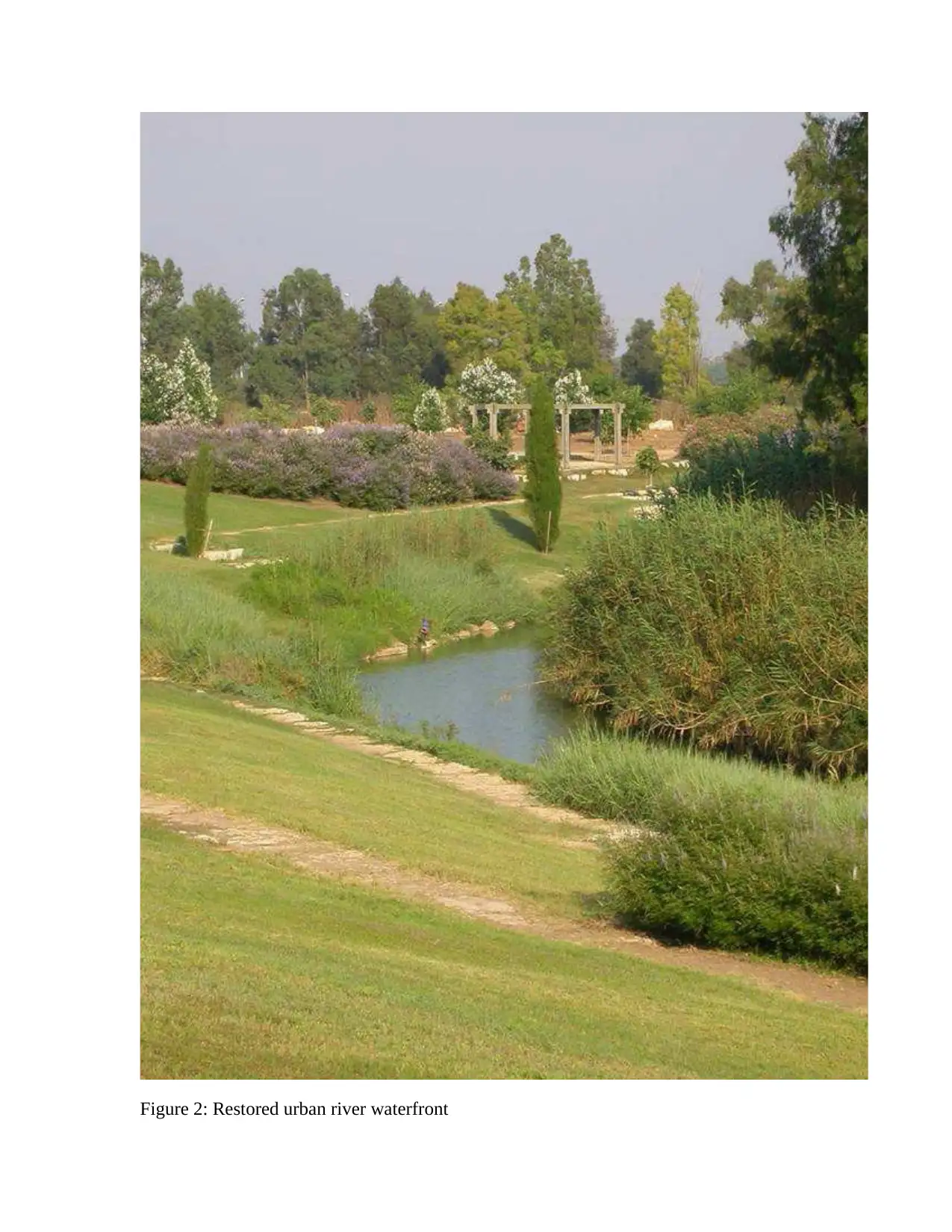
Figure 2: Restored urban river waterfront
⊘ This is a preview!⊘
Do you want full access?
Subscribe today to unlock all pages.

Trusted by 1+ million students worldwide
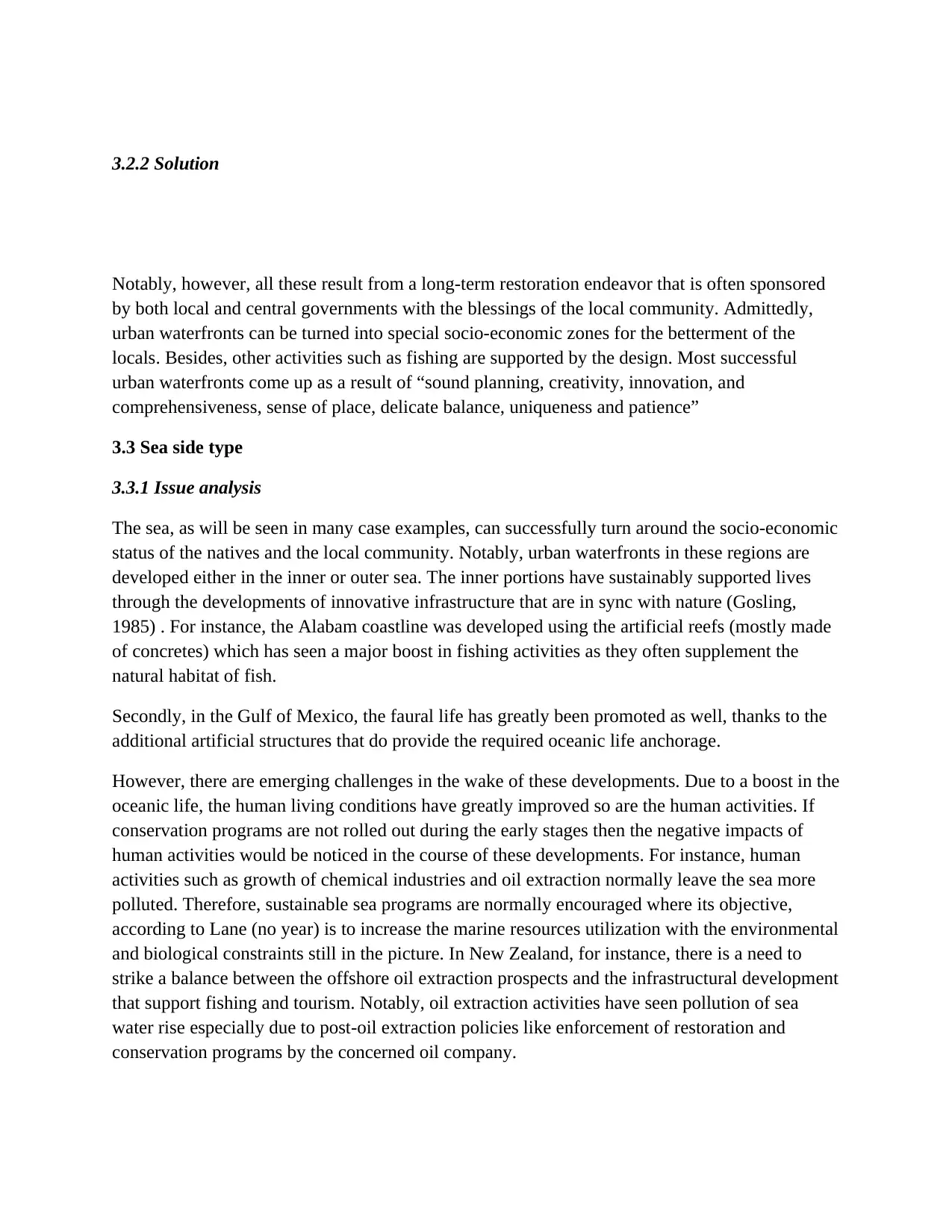
3.2.2 Solution
Notably, however, all these result from a long-term restoration endeavor that is often sponsored
by both local and central governments with the blessings of the local community. Admittedly,
urban waterfronts can be turned into special socio-economic zones for the betterment of the
locals. Besides, other activities such as fishing are supported by the design. Most successful
urban waterfronts come up as a result of “sound planning, creativity, innovation, and
comprehensiveness, sense of place, delicate balance, uniqueness and patience”
3.3 Sea side type
3.3.1 Issue analysis
The sea, as will be seen in many case examples, can successfully turn around the socio-economic
status of the natives and the local community. Notably, urban waterfronts in these regions are
developed either in the inner or outer sea. The inner portions have sustainably supported lives
through the developments of innovative infrastructure that are in sync with nature (Gosling,
1985) . For instance, the Alabam coastline was developed using the artificial reefs (mostly made
of concretes) which has seen a major boost in fishing activities as they often supplement the
natural habitat of fish.
Secondly, in the Gulf of Mexico, the faural life has greatly been promoted as well, thanks to the
additional artificial structures that do provide the required oceanic life anchorage.
However, there are emerging challenges in the wake of these developments. Due to a boost in the
oceanic life, the human living conditions have greatly improved so are the human activities. If
conservation programs are not rolled out during the early stages then the negative impacts of
human activities would be noticed in the course of these developments. For instance, human
activities such as growth of chemical industries and oil extraction normally leave the sea more
polluted. Therefore, sustainable sea programs are normally encouraged where its objective,
according to Lane (no year) is to increase the marine resources utilization with the environmental
and biological constraints still in the picture. In New Zealand, for instance, there is a need to
strike a balance between the offshore oil extraction prospects and the infrastructural development
that support fishing and tourism. Notably, oil extraction activities have seen pollution of sea
water rise especially due to post-oil extraction policies like enforcement of restoration and
conservation programs by the concerned oil company.
Notably, however, all these result from a long-term restoration endeavor that is often sponsored
by both local and central governments with the blessings of the local community. Admittedly,
urban waterfronts can be turned into special socio-economic zones for the betterment of the
locals. Besides, other activities such as fishing are supported by the design. Most successful
urban waterfronts come up as a result of “sound planning, creativity, innovation, and
comprehensiveness, sense of place, delicate balance, uniqueness and patience”
3.3 Sea side type
3.3.1 Issue analysis
The sea, as will be seen in many case examples, can successfully turn around the socio-economic
status of the natives and the local community. Notably, urban waterfronts in these regions are
developed either in the inner or outer sea. The inner portions have sustainably supported lives
through the developments of innovative infrastructure that are in sync with nature (Gosling,
1985) . For instance, the Alabam coastline was developed using the artificial reefs (mostly made
of concretes) which has seen a major boost in fishing activities as they often supplement the
natural habitat of fish.
Secondly, in the Gulf of Mexico, the faural life has greatly been promoted as well, thanks to the
additional artificial structures that do provide the required oceanic life anchorage.
However, there are emerging challenges in the wake of these developments. Due to a boost in the
oceanic life, the human living conditions have greatly improved so are the human activities. If
conservation programs are not rolled out during the early stages then the negative impacts of
human activities would be noticed in the course of these developments. For instance, human
activities such as growth of chemical industries and oil extraction normally leave the sea more
polluted. Therefore, sustainable sea programs are normally encouraged where its objective,
according to Lane (no year) is to increase the marine resources utilization with the environmental
and biological constraints still in the picture. In New Zealand, for instance, there is a need to
strike a balance between the offshore oil extraction prospects and the infrastructural development
that support fishing and tourism. Notably, oil extraction activities have seen pollution of sea
water rise especially due to post-oil extraction policies like enforcement of restoration and
conservation programs by the concerned oil company.
Paraphrase This Document
Need a fresh take? Get an instant paraphrase of this document with our AI Paraphraser
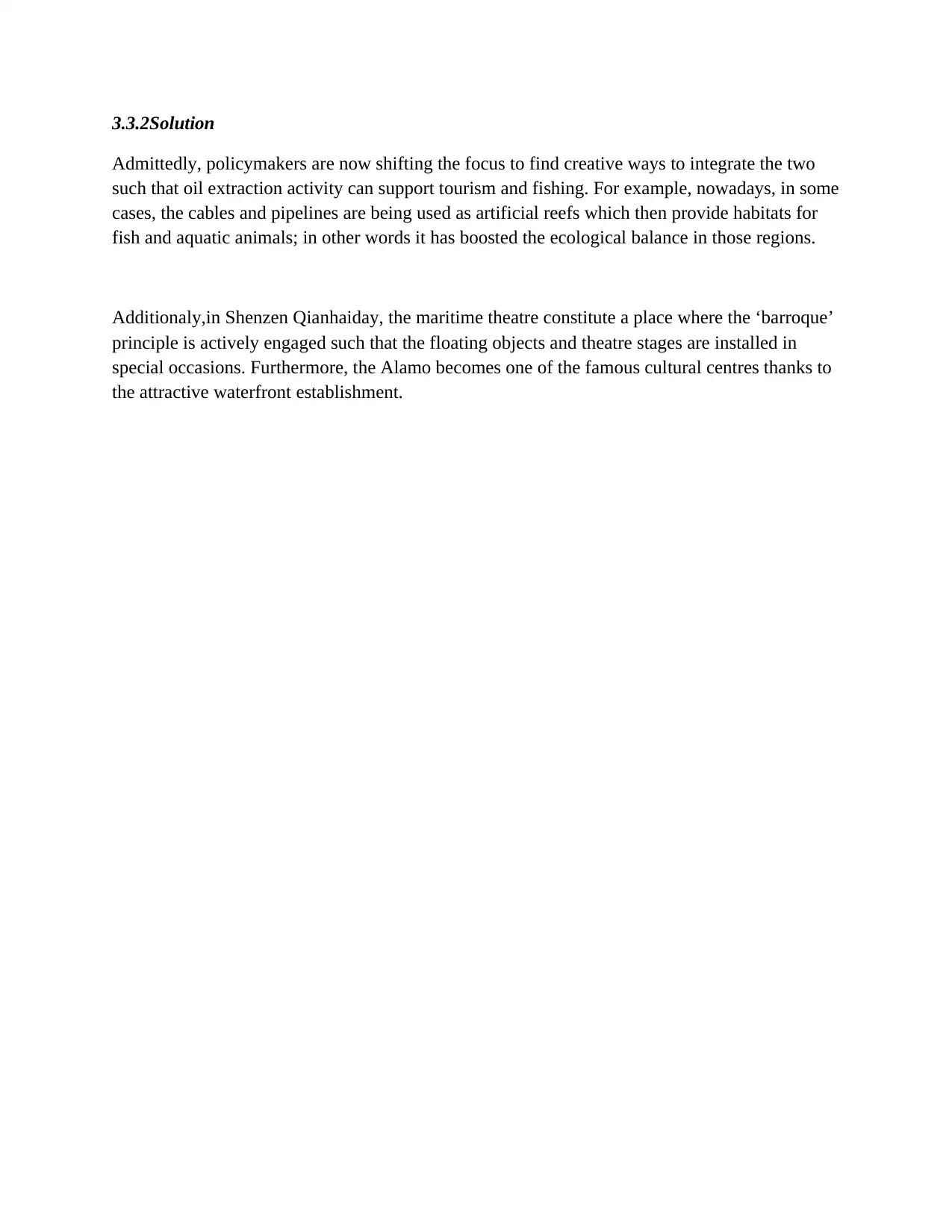
3.3.2Solution
Admittedly, policymakers are now shifting the focus to find creative ways to integrate the two
such that oil extraction activity can support tourism and fishing. For example, nowadays, in some
cases, the cables and pipelines are being used as artificial reefs which then provide habitats for
fish and aquatic animals; in other words it has boosted the ecological balance in those regions.
Additionaly,in Shenzen Qianhaiday, the maritime theatre constitute a place where the ‘barroque’
principle is actively engaged such that the floating objects and theatre stages are installed in
special occasions. Furthermore, the Alamo becomes one of the famous cultural centres thanks to
the attractive waterfront establishment.
Admittedly, policymakers are now shifting the focus to find creative ways to integrate the two
such that oil extraction activity can support tourism and fishing. For example, nowadays, in some
cases, the cables and pipelines are being used as artificial reefs which then provide habitats for
fish and aquatic animals; in other words it has boosted the ecological balance in those regions.
Additionaly,in Shenzen Qianhaiday, the maritime theatre constitute a place where the ‘barroque’
principle is actively engaged such that the floating objects and theatre stages are installed in
special occasions. Furthermore, the Alamo becomes one of the famous cultural centres thanks to
the attractive waterfront establishment.
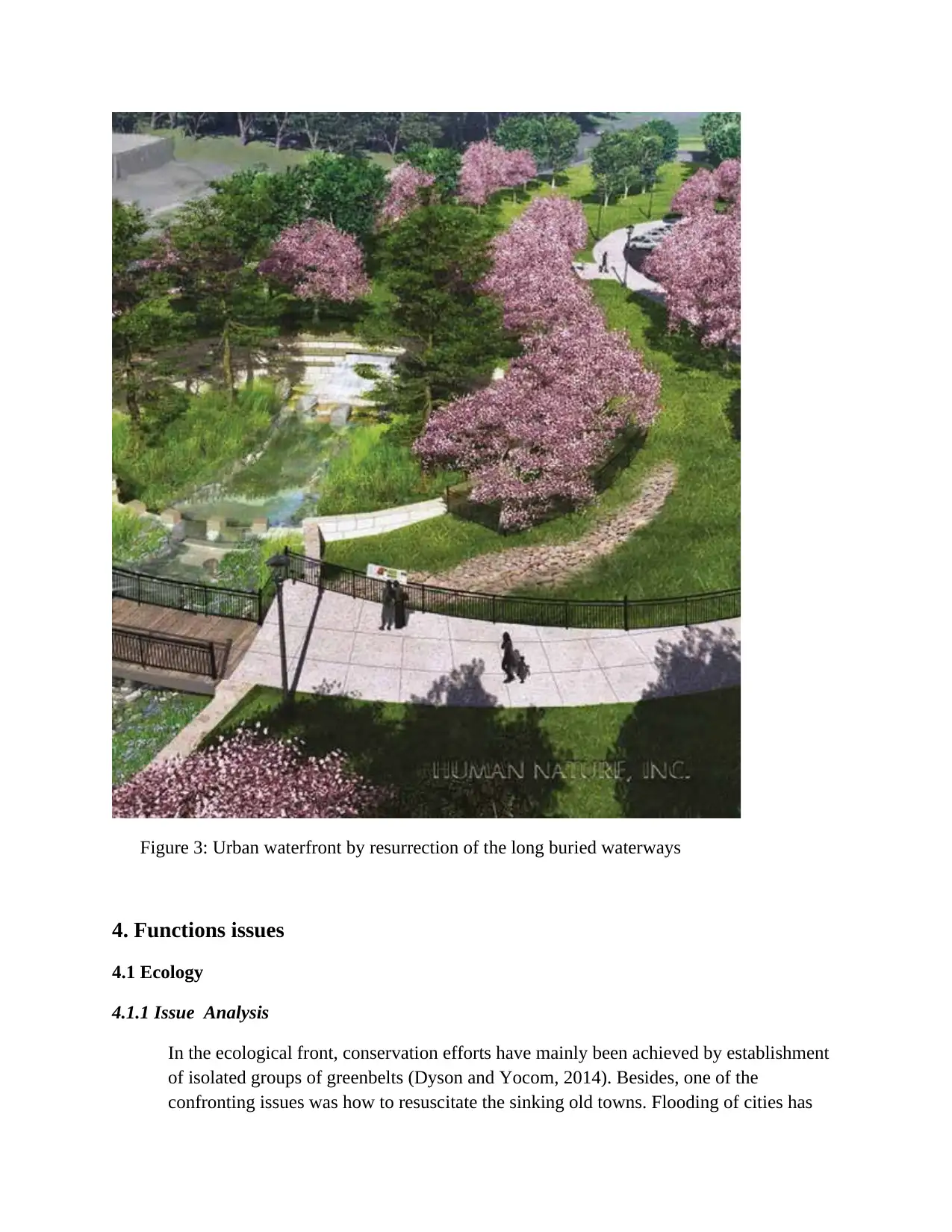
Figure 3: Urban waterfront by resurrection of the long buried waterways
4. Functions issues
4.1 Ecology
4.1.1 Issue Analysis
In the ecological front, conservation efforts have mainly been achieved by establishment
of isolated groups of greenbelts (Dyson and Yocom, 2014). Besides, one of the
confronting issues was how to resuscitate the sinking old towns. Flooding of cities has
4. Functions issues
4.1 Ecology
4.1.1 Issue Analysis
In the ecological front, conservation efforts have mainly been achieved by establishment
of isolated groups of greenbelts (Dyson and Yocom, 2014). Besides, one of the
confronting issues was how to resuscitate the sinking old towns. Flooding of cities has
⊘ This is a preview!⊘
Do you want full access?
Subscribe today to unlock all pages.

Trusted by 1+ million students worldwide
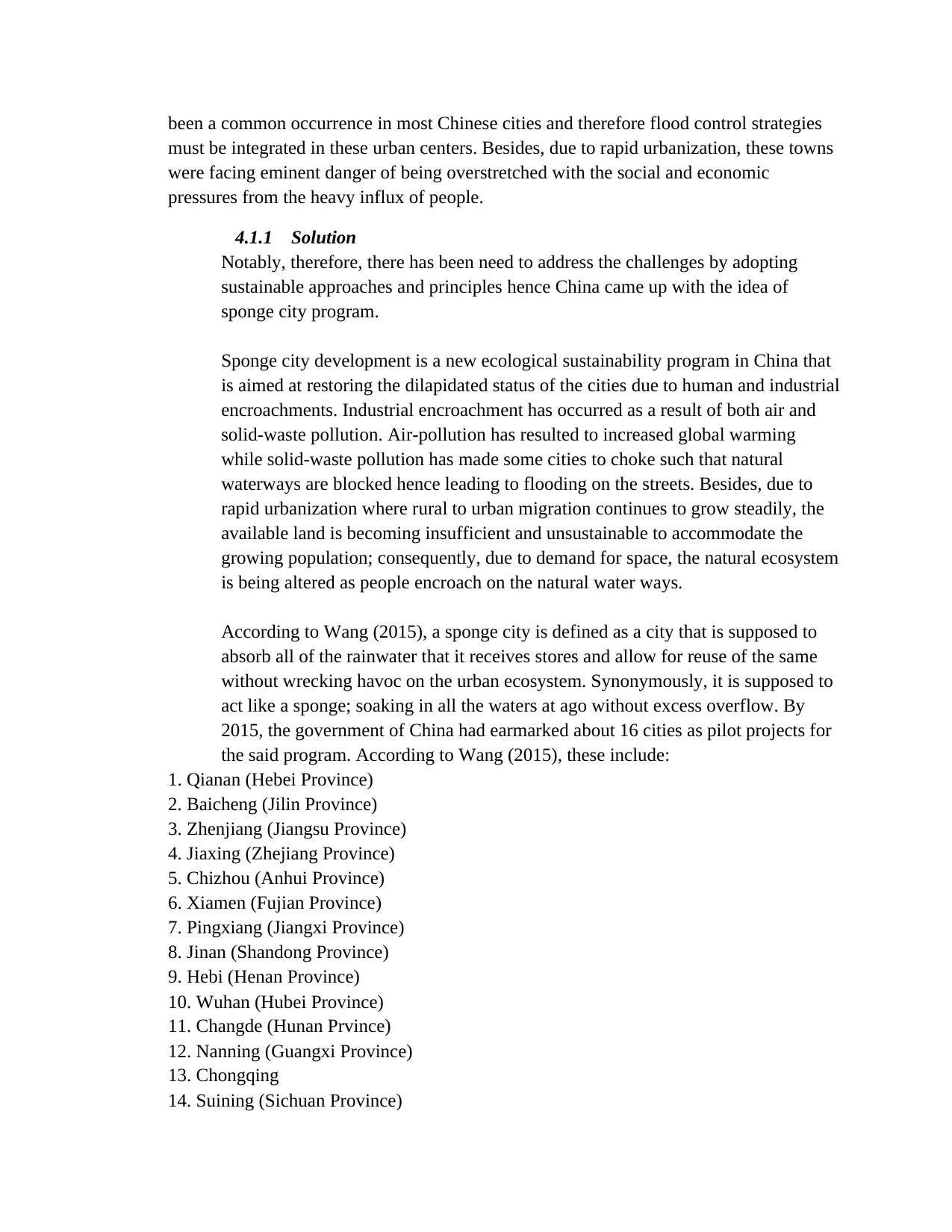
been a common occurrence in most Chinese cities and therefore flood control strategies
must be integrated in these urban centers. Besides, due to rapid urbanization, these towns
were facing eminent danger of being overstretched with the social and economic
pressures from the heavy influx of people.
4.1.1 Solution
Notably, therefore, there has been need to address the challenges by adopting
sustainable approaches and principles hence China came up with the idea of
sponge city program.
Sponge city development is a new ecological sustainability program in China that
is aimed at restoring the dilapidated status of the cities due to human and industrial
encroachments. Industrial encroachment has occurred as a result of both air and
solid-waste pollution. Air-pollution has resulted to increased global warming
while solid-waste pollution has made some cities to choke such that natural
waterways are blocked hence leading to flooding on the streets. Besides, due to
rapid urbanization where rural to urban migration continues to grow steadily, the
available land is becoming insufficient and unsustainable to accommodate the
growing population; consequently, due to demand for space, the natural ecosystem
is being altered as people encroach on the natural water ways.
According to Wang (2015), a sponge city is defined as a city that is supposed to
absorb all of the rainwater that it receives stores and allow for reuse of the same
without wrecking havoc on the urban ecosystem. Synonymously, it is supposed to
act like a sponge; soaking in all the waters at ago without excess overflow. By
2015, the government of China had earmarked about 16 cities as pilot projects for
the said program. According to Wang (2015), these include:
1. Qianan (Hebei Province)
2. Baicheng (Jilin Province)
3. Zhenjiang (Jiangsu Province)
4. Jiaxing (Zhejiang Province)
5. Chizhou (Anhui Province)
6. Xiamen (Fujian Province)
7. Pingxiang (Jiangxi Province)
8. Jinan (Shandong Province)
9. Hebi (Henan Province)
10. Wuhan (Hubei Province)
11. Changde (Hunan Prvince)
12. Nanning (Guangxi Province)
13. Chongqing
14. Suining (Sichuan Province)
must be integrated in these urban centers. Besides, due to rapid urbanization, these towns
were facing eminent danger of being overstretched with the social and economic
pressures from the heavy influx of people.
4.1.1 Solution
Notably, therefore, there has been need to address the challenges by adopting
sustainable approaches and principles hence China came up with the idea of
sponge city program.
Sponge city development is a new ecological sustainability program in China that
is aimed at restoring the dilapidated status of the cities due to human and industrial
encroachments. Industrial encroachment has occurred as a result of both air and
solid-waste pollution. Air-pollution has resulted to increased global warming
while solid-waste pollution has made some cities to choke such that natural
waterways are blocked hence leading to flooding on the streets. Besides, due to
rapid urbanization where rural to urban migration continues to grow steadily, the
available land is becoming insufficient and unsustainable to accommodate the
growing population; consequently, due to demand for space, the natural ecosystem
is being altered as people encroach on the natural water ways.
According to Wang (2015), a sponge city is defined as a city that is supposed to
absorb all of the rainwater that it receives stores and allow for reuse of the same
without wrecking havoc on the urban ecosystem. Synonymously, it is supposed to
act like a sponge; soaking in all the waters at ago without excess overflow. By
2015, the government of China had earmarked about 16 cities as pilot projects for
the said program. According to Wang (2015), these include:
1. Qianan (Hebei Province)
2. Baicheng (Jilin Province)
3. Zhenjiang (Jiangsu Province)
4. Jiaxing (Zhejiang Province)
5. Chizhou (Anhui Province)
6. Xiamen (Fujian Province)
7. Pingxiang (Jiangxi Province)
8. Jinan (Shandong Province)
9. Hebi (Henan Province)
10. Wuhan (Hubei Province)
11. Changde (Hunan Prvince)
12. Nanning (Guangxi Province)
13. Chongqing
14. Suining (Sichuan Province)
Paraphrase This Document
Need a fresh take? Get an instant paraphrase of this document with our AI Paraphraser
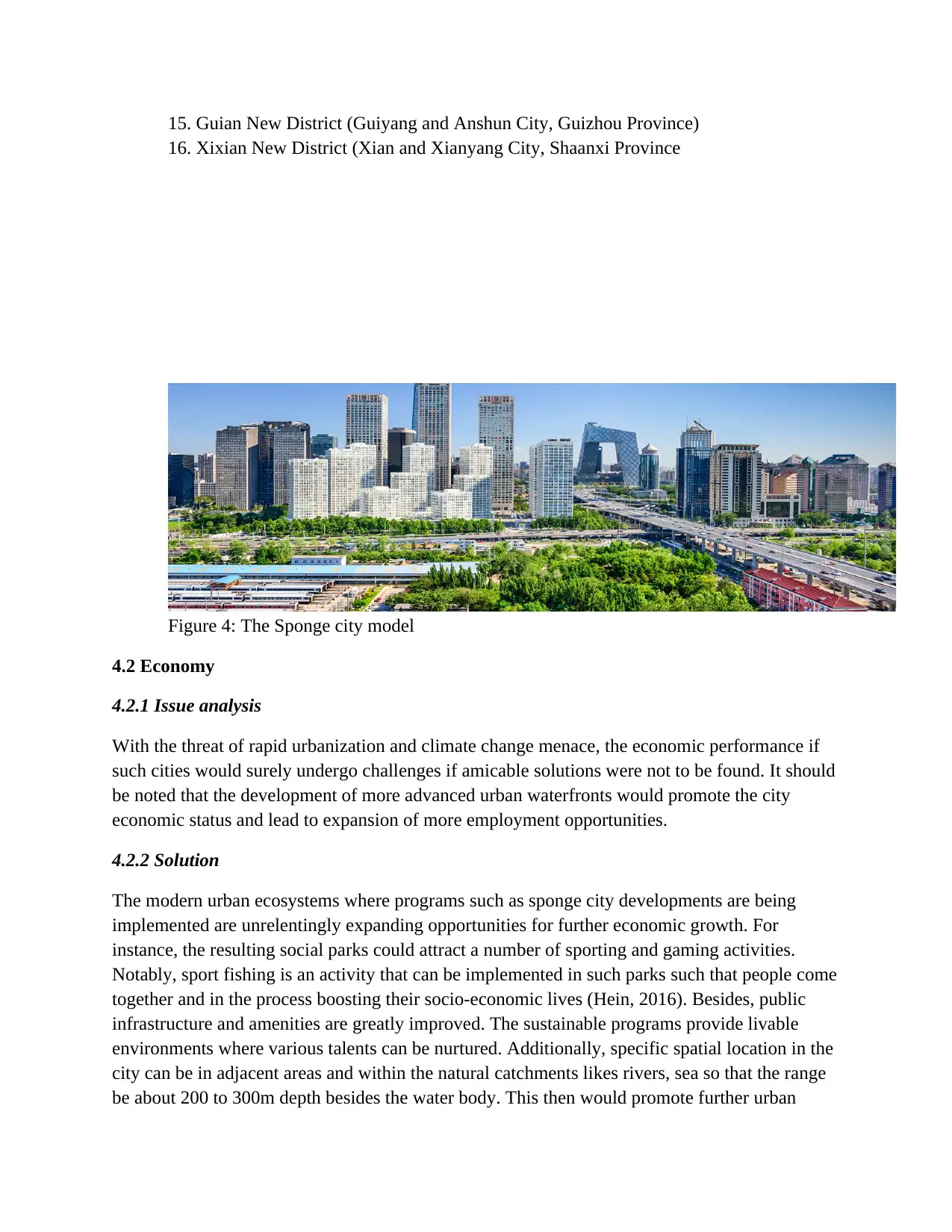
15. Guian New District (Guiyang and Anshun City, Guizhou Province)
16. Xixian New District (Xian and Xianyang City, Shaanxi Province
Figure 4: The Sponge city model
4.2 Economy
4.2.1 Issue analysis
With the threat of rapid urbanization and climate change menace, the economic performance if
such cities would surely undergo challenges if amicable solutions were not to be found. It should
be noted that the development of more advanced urban waterfronts would promote the city
economic status and lead to expansion of more employment opportunities.
4.2.2 Solution
The modern urban ecosystems where programs such as sponge city developments are being
implemented are unrelentingly expanding opportunities for further economic growth. For
instance, the resulting social parks could attract a number of sporting and gaming activities.
Notably, sport fishing is an activity that can be implemented in such parks such that people come
together and in the process boosting their socio-economic lives (Hein, 2016). Besides, public
infrastructure and amenities are greatly improved. The sustainable programs provide livable
environments where various talents can be nurtured. Additionally, specific spatial location in the
city can be in adjacent areas and within the natural catchments likes rivers, sea so that the range
be about 200 to 300m depth besides the water body. This then would promote further urban
16. Xixian New District (Xian and Xianyang City, Shaanxi Province
Figure 4: The Sponge city model
4.2 Economy
4.2.1 Issue analysis
With the threat of rapid urbanization and climate change menace, the economic performance if
such cities would surely undergo challenges if amicable solutions were not to be found. It should
be noted that the development of more advanced urban waterfronts would promote the city
economic status and lead to expansion of more employment opportunities.
4.2.2 Solution
The modern urban ecosystems where programs such as sponge city developments are being
implemented are unrelentingly expanding opportunities for further economic growth. For
instance, the resulting social parks could attract a number of sporting and gaming activities.
Notably, sport fishing is an activity that can be implemented in such parks such that people come
together and in the process boosting their socio-economic lives (Hein, 2016). Besides, public
infrastructure and amenities are greatly improved. The sustainable programs provide livable
environments where various talents can be nurtured. Additionally, specific spatial location in the
city can be in adjacent areas and within the natural catchments likes rivers, sea so that the range
be about 200 to 300m depth besides the water body. This then would promote further urban
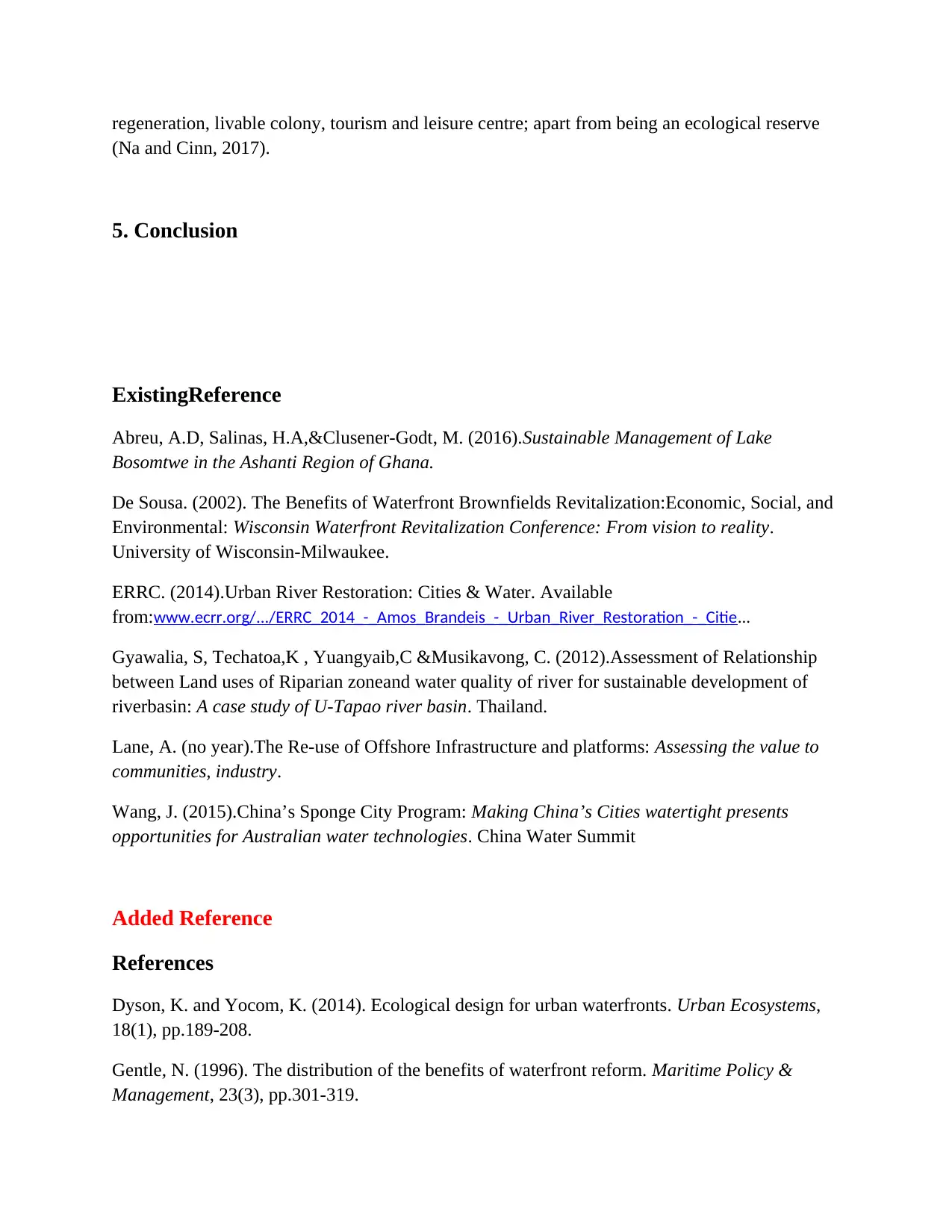
regeneration, livable colony, tourism and leisure centre; apart from being an ecological reserve
(Na and Cinn, 2017).
5. Conclusion
ExistingReference
Abreu, A.D, Salinas, H.A,&Clusener-Godt, M. (2016).Sustainable Management of Lake
Bosomtwe in the Ashanti Region of Ghana.
De Sousa. (2002). The Benefits of Waterfront Brownfields Revitalization:Economic, Social, and
Environmental: Wisconsin Waterfront Revitalization Conference: From vision to reality.
University of Wisconsin-Milwaukee.
ERRC. (2014).Urban River Restoration: Cities & Water. Available
from:www.ecrr.org/.../ERRC_2014_-_Amos_Brandeis_-_Urban_River_Restoration_-_Citie...
Gyawalia, S, Techatoa,K , Yuangyaib,C &Musikavong, C. (2012).Assessment of Relationship
between Land uses of Riparian zoneand water quality of river for sustainable development of
riverbasin: A case study of U-Tapao river basin. Thailand.
Lane, A. (no year).The Re-use of Offshore Infrastructure and platforms: Assessing the value to
communities, industry.
Wang, J. (2015).China’s Sponge City Program: Making China’s Cities watertight presents
opportunities for Australian water technologies. China Water Summit
Added Reference
References
Dyson, K. and Yocom, K. (2014). Ecological design for urban waterfronts. Urban Ecosystems,
18(1), pp.189-208.
Gentle, N. (1996). The distribution of the benefits of waterfront reform. Maritime Policy &
Management, 23(3), pp.301-319.
(Na and Cinn, 2017).
5. Conclusion
ExistingReference
Abreu, A.D, Salinas, H.A,&Clusener-Godt, M. (2016).Sustainable Management of Lake
Bosomtwe in the Ashanti Region of Ghana.
De Sousa. (2002). The Benefits of Waterfront Brownfields Revitalization:Economic, Social, and
Environmental: Wisconsin Waterfront Revitalization Conference: From vision to reality.
University of Wisconsin-Milwaukee.
ERRC. (2014).Urban River Restoration: Cities & Water. Available
from:www.ecrr.org/.../ERRC_2014_-_Amos_Brandeis_-_Urban_River_Restoration_-_Citie...
Gyawalia, S, Techatoa,K , Yuangyaib,C &Musikavong, C. (2012).Assessment of Relationship
between Land uses of Riparian zoneand water quality of river for sustainable development of
riverbasin: A case study of U-Tapao river basin. Thailand.
Lane, A. (no year).The Re-use of Offshore Infrastructure and platforms: Assessing the value to
communities, industry.
Wang, J. (2015).China’s Sponge City Program: Making China’s Cities watertight presents
opportunities for Australian water technologies. China Water Summit
Added Reference
References
Dyson, K. and Yocom, K. (2014). Ecological design for urban waterfronts. Urban Ecosystems,
18(1), pp.189-208.
Gentle, N. (1996). The distribution of the benefits of waterfront reform. Maritime Policy &
Management, 23(3), pp.301-319.
⊘ This is a preview!⊘
Do you want full access?
Subscribe today to unlock all pages.

Trusted by 1+ million students worldwide
1 out of 13
Related Documents
Your All-in-One AI-Powered Toolkit for Academic Success.
+13062052269
info@desklib.com
Available 24*7 on WhatsApp / Email
![[object Object]](/_next/static/media/star-bottom.7253800d.svg)
Unlock your academic potential
Copyright © 2020–2025 A2Z Services. All Rights Reserved. Developed and managed by ZUCOL.





